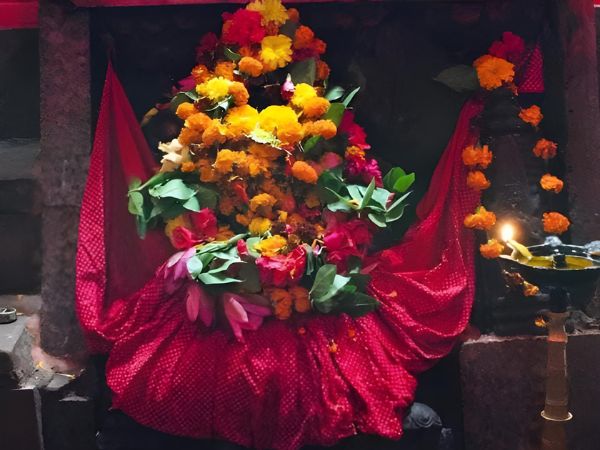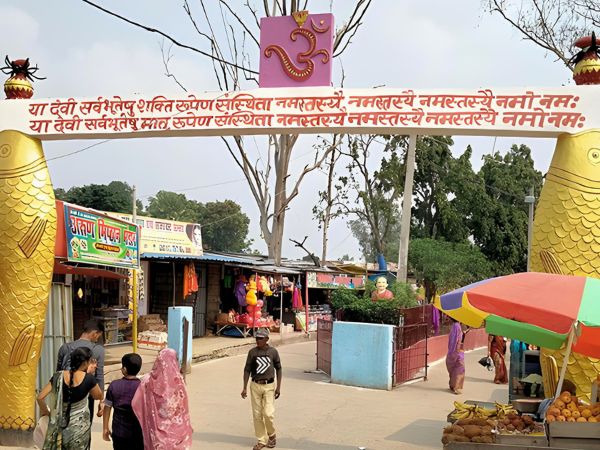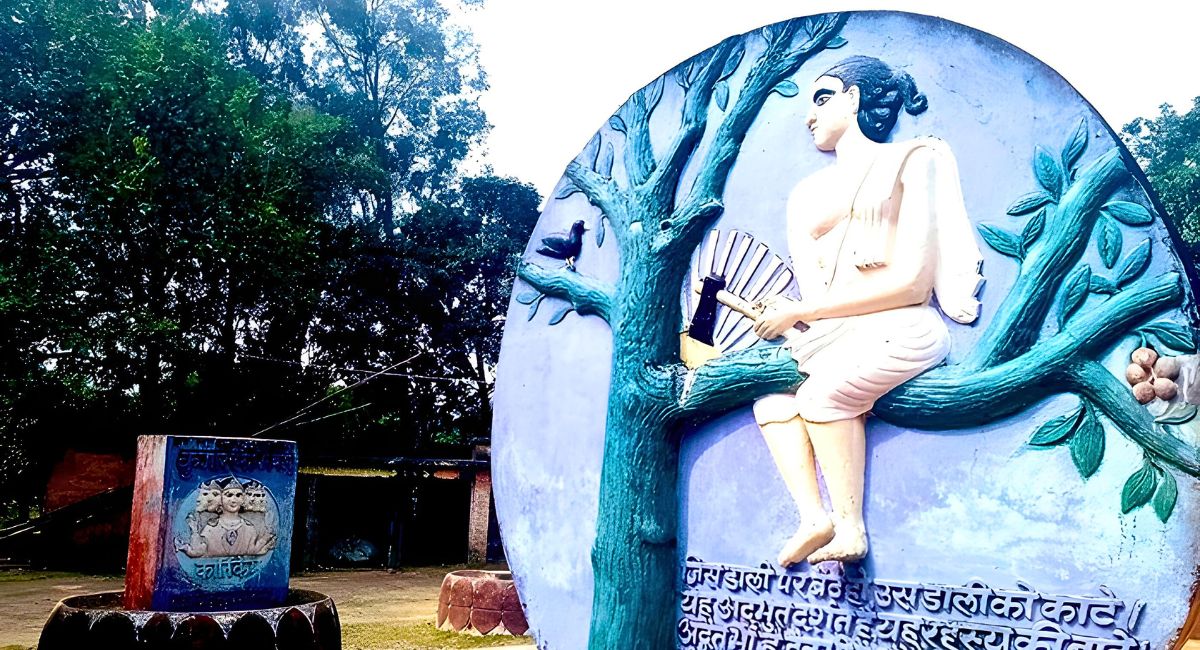Kalidasa, often referred to locally as Kalidas, stands as one of the most prominent figures in Sanskrit literature, firmly established in India’s rich cultural and literary heritage. Celebrated for his extraordinary literary prowess, Kalidasa’s works masterfully intertwine profound emotional resonance with exquisite imagery and linguistic finesse.
His timeless poetry and plays have not only left an indelible mark on the literary landscape but have also inspired countless writers, poets, and artists through the ages. As a beacon of artistic excellence, Kalidasa’s legacy continues to illuminate the realms of literature and drama, captivating the hearts and minds of generations.
Index of Contents
History
Kalidasa is believed to have lived during the Gupta period (approximately 4th to 5th century CE), a time often referred to as the “Golden Age” of India. This era was characterized by significant advancements in arts, literature, science, and philosophy.
The stability of the Gupta Empire allowed for a flourishing of cultural activities, providing fertile ground for literary giants like Kalidasa to emerge. Kalidasa’s life remains shrouded in mystery. Scholars have speculated that he may have been born between the 1st century BCE and the 5th century CE, with various opinions about his birthplace.
Some believe he was born in Ujjain, a city in present-day Madhya Pradesh, while others suggest Rudraprayag district in Uttarakhand or the region around Kalinga. The Government of India has even constructed an auditorium in Kaviltha village and erected a statue in his honor.
According to folklore, Kalidasa was initially illiterate and did not understand much about literature. However, after marrying a princess named Vidyottama, who was unaware of his lack of knowledge, he was expelled from her home upon revelation of his illiteracy.
Transformation
In the tranquil district of Madhubani, Bihar, lies a story of divine intervention and transformation, one that surrounds the legendary poet Kalidas. Once known for his lack of wisdom, it is believed that Kalidas received the gift of knowledge from Maa Bhagwati at the sacred Uchaith Bhagwati temple.

This pivotal moment marked a miraculous change in his life, endowing him with the extraordinary intellect and poetic genius that would forever define him as Mahakavi Kalidas. Today, at the very site known as Kalidas Deeh Sthal in Uchaith village, the echoes of his spiritual journey continue to resonate.
Just five kilometers from the Benipatti block headquarters, this sacred land draws pilgrims and literary enthusiasts alike, eager to connect with the enduring legend of Kalidas. The hill, where the Deeh Sthal stands tall at two hundred meters above the village, holds within it the rich lore and ancient wisdom associated with this revered figure in Sanskrit literature.
Adjacent to this spiritual site is the temple of Maa Chhinnamastika Bhagwati, also known as Uchaith Bhagwati. It is said that through his deep devotion to the goddess, Kalidas received her divine blessings, transforming him into one of history’s greatest poets.
His works, including the masterpieces Meghaduta and Shakuntala, continue to leave an indelible mark on Indian literature, carrying the inspiration of his divine encounter. To this day, Kalidas’ legacy is honored through various efforts in Uchaith.
A science college bearing his name stands as a tribute to his brilliance, and each year, a state festival is held to celebrate his unparalleled contributions to Sanskrit and Indian culture. The local community, proud of their connection to this historic land, has long been advocating for Uchaith to be recognized as a tourist destination.
For many, this is not just a place of learning but a sacred land touched by the blessings of Maa Bhagwati and the genius of Mahakavi Kalidas, whose influence transcends time.
Literary Career
Kalidasa’s literary career is marked by a collection of celebrated works that include plays, poems, and epic narratives, reflecting his profound understanding of human emotions and the natural world.
Major Works
Shakuntala
Shakuntala is perhaps Kalidasa’s most famous play, depicting the love story between Shakuntala and King Dushyanta. The narrative is rich with themes of love, loss, and destiny, culminating in a poignant exploration of memory and identity.
The play’s emotional depth and lyrical beauty have made it a cornerstone of Indian theatre, inspiring adaptations in various languages and art forms worldwide. The plot revolves around Shakuntala, the daughter of the sage Vishwamitra, and the celestial nymph Menaka.
Dushyanta, while on a hunting expedition, meets Shakuntala in the forest, and they fall in love. After their marriage, Dushyanta returns to his kingdom but forgets Shakuntala due to a curse. The climax revolves around Shakuntala’s struggle to regain Dushyanta’s love, symbolizing the trials of love and fate.
Meghaduta
Meghaduta is a lyrical poem that tells the story of a forlorn lover who sends a message to his beloved through a cloud. This work exemplifies Kalidasa’s mastery of nature imagery and emotional expression, intertwining themes of longing and separation.
The poem is celebrated for its vivid descriptions of landscapes and the changing seasons, establishing a deep connection between human emotions and the natural world. The poem is structured in two parts, with the first part describing the protagonist’s sorrow and the beauty of the natural world.
The second part follows the cloud as it travels to the beloved’s abode, filled with poetic imagery that enhances the themes of love and longing.
Ritu Samhara
Ritu Samhara is another notable work, composed of six cantos, each celebrating a different season (Ritu). Kalidasa captures the beauty of nature and its profound influence on human life and emotions, showcasing his exceptional ability to weave poetic language with vivid imagery.
Each canto highlights the characteristics of a specific season, exploring how nature’s changes reflect the emotions of love and passion. The poem emphasizes the cyclical nature of life and love, showcasing Kalidasa’s philosophical depth.
Kumarasambhava
Kumarasambhava, an epic poem, narrates the birth of Lord Kartikeya, the son of Lord Shiva and Parvati. This work explores themes of love, power, and the divine, embodying a rich tapestry of mythology and spirituality that is characteristic of Kalidasa’s writings.
The narrative begins with the union of Shiva and Parvati, detailing their love story and the challenges they faced before the birth of their son. The poem combines mythology with rich descriptions of nature and cosmic elements, highlighting the significance of divine intervention in human affairs.
Contributions
Mahakabi Kalidasa’s writing is distinguished by its lyrical quality, sophisticated use of metaphors, and keen observation of nature. His ability to depict human emotions—ranging from love and jealousy to sorrow and joy—resonates deeply with readers.
He masterfully blends classical themes with a fresh perspective, ensuring that his works remain relevant across generations. His poetic style is characterized by intricate wordplay, vivid imagery, and emotional resonance.
Kalidasa’s use of allegory and symbolism deepens the meaning of his works, inviting readers to engage with the text on multiple levels. His influence is evident in the works of later poets and playwrights, who drew inspiration from his themes, style, and exploration of human emotions.
Influence
Impact on Indian Literature
Kalidasa’s influence on Indian literature is profound. His works set a benchmark for subsequent generations of poets and playwrights, inspiring countless adaptations and reinterpretations. Many writers across various Indian languages have drawn inspiration from his themes and styles, making him a pivotal figure in the literary canon. His plays continue to be performed, and his poetry is studied in schools and universities across India.
Kalidasa in Art and Culture
The legacy of Kalidasa extends beyond literature into various forms of art, including classical dance, theatre, and visual arts. His stories have been adapted into numerous plays, ballets, and operas, showcasing the timelessness of his narratives.
The beauty of his poetry continues to inspire contemporary artists, dancers, and filmmakers. Kalidasa’s works have been adapted into modern theatre and films, often reinterpreted to suit contemporary audiences while retaining the essence of the original texts. His influence can also be seen in classical dance forms, where dancers embody the emotions and narratives present in his poetry.
The Indian Shakespeare
Kalidasa is often revered as one of the nine gems (Navaratnas) of King Vikramaditya, celebrated for his profound contributions to classical literature. His poetic works predominantly revolve around the following themes:
- Illustrating Mother Earth: His poetry personifies Mother Earth, emphasizing her nurturing qualities and the interconnectedness of all living beings.
- Expressing Love for Nature: Kalidasa’s poetry beautifully encapsulates his deep admiration for the natural world, portraying its beauty and intricacies.
- Praising the Seasons and Monsoons: His writings reflect a deep appreciation for the changing seasons, particularly the monsoons, which he glorifies as a vital and life-giving force in nature.
- Glorifying the Fields and Sky: Kalidasa’s works often highlight the rich landscapes, fertile fields, and expansive skies, celebrating the harmony between earth and heaven.
Through these themes, Kalidasa’s works offer a soul-satisfying peace that resonates with readers. His sincerity and authentic expression exemplify the truth of his nature, drawing parallels to the literary depth found in the works of William Shakespeare.
Honors
Shakespeare of India
In modern times, Kalidasa is often referred to as the “Shakespeare of India,” highlighting his unparalleled contribution to literature. Various literary awards and festivals in India are named in his honor, celebrating his lasting impact on the cultural landscape.
His works have been translated into multiple languages, making them accessible to a global audience. Institutions and organizations celebrate Kalidasa’s legacy through seminars, workshops, and cultural events, fostering appreciation for his contributions to literature and arts.
A three-day literary seminar is organized annually in June at the auditorium constructed in Kaviltha village, bringing together scholars from various parts of the country to discuss his works and influence.
Kalidas Dih

A historical and revered site located in the village of Uchchaith Sthan in Madhubani district, Bihar, holds deep significance in the life of the great Sanskrit scholar and poet, Kalidasa.
This sacred spot is closely associated with his literary and spiritual journey, marking a place where he found divine enlightenment and intellectual awakening through the blessings of Uchchaith Bhagwati.
At the heart of this village stands a prominent mud mound known as Kalidas Dih. This mound serves as a memorial to Kalidasa, featuring statues of the poet and representations of his celebrated works.
It is widely believed that Kalidasa wrote many of his renowned compositions here, including masterpieces that shaped Indian literature. The surroundings of Kalidas Dih are said to have inspired his profound creativity and wisdom, transforming him into the Mahakavi (Great Poet) we revere today.
In addition to its literary significance, Kalidas Dih is recognized as a sacred site, where Kalidasa received the boon of knowledge from Maa Uchchaith Bhagwati. Legends say that his earlier years were spent in a nearby Gurukul, where he immersed himself in learning and devotion. This spiritual connection with the land remains an enduring part of local belief.
Each year in October, the Bihar Government organizes the Mahakavi Kalidas Mahotsav, a grand festival in Kalidasa’s memory, to honor his contributions to Sanskrit literature and Indian culture. This event draws scholars, devotees, and literary enthusiasts from across the country, to celebrate his timeless works and spiritual journey.
Recognized as a tourist center, Kalidas Dih is not only a pilgrimage site for Hindus but also a place of historical and cultural importance, deeply woven into the rich heritage of India.
Lesser Known Facts
- Kalidasa as the Indian Shakespeare: Kalidasa is often referred to as the Indian Shakespeare due to his profound influence on classical literature and his mastery of poetic expression. He is celebrated as the Prince of Indian Poets, recognized for his emotional depth and exquisite use of language.
- First Poetic Work: “Ritusamhara” (ऋतु संहार) is considered Kalidasa’s first poetic work, showcasing his talent for depicting the beauty of nature and the changing seasons. This poem lays the foundation for his subsequent literary achievements.
- Epic Poems: Among Kalidasa’s most renowned works are “Raghuvamsa” (रघुवंश) and “Kumarasambhava” (कुमारसंभव), both of which are epic poems. “Raghuvamsa” narrates the lineage of the Raghu dynasty, while “Kumarasambhava” details the birth of Lord Kartikeya, blending mythology with rich poetic imagery.
- Royal Patronage: During his reign, Kalidasa was associated with Gupta King Chandragupta II, who ruled in the 4th to 5th centuries CE. Kalidasa was honored as one of the Nine Jewels (Navaratnas) at Chandragupta II’s court, highlighting his esteemed position in the cultural and literary circles of the time.
- Inscriptions: Kalidasa is referenced in historical records, such as the Aihole Inscription and the Hanamkonda Inscription. These inscriptions provide valuable insights into his contributions to literature and the esteem in which he was held in ancient Indian society.
In summary, Kalidasa remains a towering figure in the world of classical literature, revered for his lyrical genius and profound insights into human emotions. His works not only reflect the beauty of nature but also capture the essence of the human experience, making him an enduring symbol of creativity and artistic expression.

